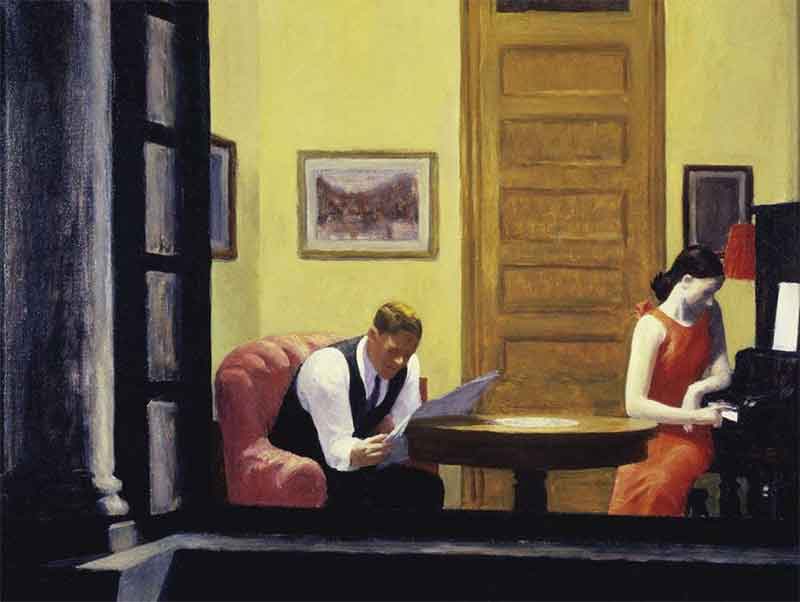Unsparing gazes: visions of America from colonial times to the present – four online talks by Mary Lynn Riley
posted on 29/06/21
From Revolutionary times to the current quest for racial justice, artists in America have kept their finger on the pulse of the nation. This four-part series of online talks takes a look at some of America’s most important figurative painters whose works reveal the concerns and attitudes of an evolving society in the straightforward, uncompromising manner that has always defined the best in American art. These artists record the emergence of the American character as the country gained its independence, the development of a forward-looking society contrasted with nostalgia for the past in the later 19th century, the growing divide between rural and urban life in the 1930s and, finally, they address the complex experience of Afro-Americans.
They take place every Thursday from 4 to 25 November at 4.30pm (GMT) and, including Q&A, will probably last just under an hour. They are available for viewing for eight weeks after the last episode is streamed (20 January 2022).
Register for the webinar series for £55
Frequently asked questions
What methods of payment do you accept?
An electronic invoice will be sent to your e-mail address 1–3 working days after you have completed our registration form. Payment can be made online using AMEX, Apple Pay, Google Pay, MasterCard or Visa.
How do I purchase the webinar series as a gift?
Please contact us specifying how many subscriptions you would like and who they are for (we require their full name and e-mail address). We will invoice you directly, and after we have received your payment we will release the webinar joining instructions to your friend(s) or family member(s).
Can I purchase a single episode?
No, unfortunately not. The series must be purchased in full.
How do I join the webinar?
An e-mail confirmation will be sent to you after you have paid for your subscription, which includes your unique link for joining the webinar. Reminder e-mails will be sent to you one day and one hour before each event. We recommend that you download the Zoom software in advance of the first webinar.
Can I watch the live broadcast(s) on more than one device?
Only one device can be connected to the live broadcast(s) at any one time. If you wish to purchase a second subscription, please contact us.
What happens if I am unable to attend the live broadcast(s)?
A recording will be uploaded to a dedicated webpage approximately two hours after the live broadcast. For copyright reasons, these recordings cannot be made available indefinitely; access is granted for eight weeks after the final live broadcast of the series.
The talks
1. Becoming American: two revolutionary regards (4th November 2021)
John Singleton Copley and Charles Willson Peale were the two leading painters of colonial times. The first dreamed of becoming an English painter in the grand tradition, the second fought to establish the arts firmly in America. Both set new precedents in portraiture and captured the distinctively American character of their sitters on canvas.
2. After the Civil War: suspended between past and future (11th November 2021)
American society after the Civil War was increasingly complex and disparate. Painters Winslow Homer and Thomas Eakins were probably the keenest observers of the sobered country. Artists, such as Winslow Homer painted woodsman, farmers, fishermen, and children who represented a longing for a simpler past. Eakins’ subjects were middle-class Philadelphians who excelled in science, sports, and the arts. These two visions of the country remain ingrained to this day.
3. The Great Depression: Regionalism and urban disillusion (18th November 2021)
Contrasting visions of urban and rural life continued to be explored during the period of the Great Depression with its economic crisis and social upheaval. Grant Wood and Thomas Hart Benton are the most well-known proponents of Regionalist Art. Edward Hopper and Reginald Marsh represented the city; Hopper leaving us iconic images the isolated individual, and Marsh, of the teeming masses.
4. An Afro-American story: revealing the invisible (25th November 2021)
Afro-Americans are becoming increasingly prominent on the national and international art scene. Robert Colescott, Kerry James Marshall, and Kara Walker are three major artists who have addressed, frequently with biting humour, the often untold history of black life in the United Sates, racial stereotypes and the absence of black people in the history of art.
Register for the webinar series for £55
Image: Room in New York, Edward Hopper (1932).
